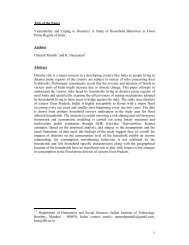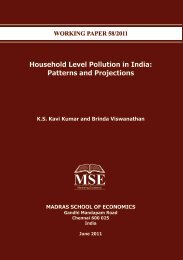The Tehri Dam Project - Envis
The Tehri Dam Project - Envis
The Tehri Dam Project - Envis
You also want an ePaper? Increase the reach of your titles
YUMPU automatically turns print PDFs into web optimized ePapers that Google loves.
THE TEHRI DAM PROJECT<br />
<strong>The</strong> rivers Bhagirathi and Bhilangana rise in the Garhwal Himalayas in<br />
northwestern Uttar Pradesh and flow south to the plains as the Ganga. As part of<br />
a larger plan to trap the waters of the Upper Ganga basin, a three billion dollar<br />
clay core, rock fill dam is being constructed at the confluence of the Bhagirathi<br />
and Bhilangana, close to the Garhwal town of <strong>Tehri</strong>. <strong>The</strong> lake created by the dam<br />
will extend upto 45 kms in the Bhagirathi Valley and 25 kms in the Bhilangana<br />
Valley with a water-spread area of 42.5 sq. kms. It will submerge nearly 100<br />
villages, including <strong>Tehri</strong>, a historical capital. As many as 85,600 families will be<br />
relocated as a result. 19 On the benefits side of the equation, the project is<br />
supposed to generate 2,400 MW of electricity, create irrigation facilities for<br />
270,000 hectares of land, and create a supply of 500 cusecs of water to New<br />
Delhi.
<strong>The</strong> <strong>Tehri</strong> dam project has provoked controversy focused on three issues.<br />
<strong>The</strong> completed dam will displace many people and submerge several towns,<br />
among them the town of <strong>Tehri</strong>; the region is vulnerable to earthquakes and the<br />
dam may be structurally incapable of withstanding them or may perhaps even<br />
cause them; and the possible failure of the dam could kill hundreds of thousands<br />
of people and destroy downstream towns of immense religious significance. Of<br />
particular concern are the 170,000 inhabitants of the down streams Hindu holy<br />
towns of Hardwar and Rishikesh. Both the resettlement policies and the<br />
structural flaws of the dam have provoked civil protests, lawsuits and<br />
international attention that have repeatedly stalled the project, which was begun<br />
in 1978.<br />
<strong>The</strong> <strong>Tehri</strong> project was unsuccessfully challenged in the Supreme Court in a<br />
writ petition filed by the <strong>Tehri</strong> Bandh Virodhi Sangarash Samiti (TBVSS) in 1985.<br />
In April 1987 the Indian National Trust for Art and Cultural Heritage (INTACH),<br />
an 'intervenor' in this petition and a leading non-governmental organization in<br />
the field of conservation, sponsored an independent assessment of the economic<br />
feasibility of the dam. <strong>The</strong> principal finding of the multi-disciplinary team that<br />
conducted the appraisal was that the benefit to cost ratio of the <strong>Tehri</strong> dam, after<br />
calculating social and environmental costs and benefits, works out to 0.56:1, well<br />
short of the 1.5:1 ratio adopted by the Planning Commission to sanction such<br />
projects.<br />
In -addition, in 1986, the Soviet Union agreed to help fund the project with<br />
loans at extremely concessional terms. As a part of the agreement with the<br />
Indian Government, Soviet experts conducted a review of the proposed project<br />
and made several ominous findings, the most frightening of which was that the<br />
high seismicity of the <strong>Tehri</strong> area had not been adequately taken into<br />
consideration by Indian planners. <strong>The</strong> INTACH team, under the leadership of<br />
Vijay Paranjpye, also found that while the Indian Government projected a useful<br />
life of 100 years, the actual siltation rate would render the dam useless in 62
years or less. Finally, while the authorities put the number of displaced people,<br />
or oustees at 46,000, the INTACH team found that 85,600 people would be<br />
displaced by the project.<br />
<strong>The</strong> Supreme Court dismissed the petition in 1990 after a very limited<br />
enquiry. Although the Environmental Appraisal Committee had unanimously<br />
concluded that the <strong>Tehri</strong> project should not be approved, the Central<br />
Government relied instead on an opinion of the Department of Mines to convince<br />
itself and the court that the project was sound.



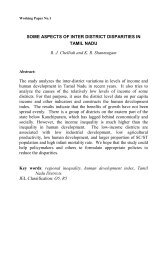
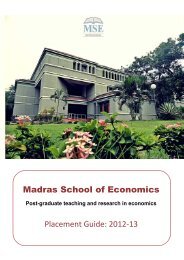
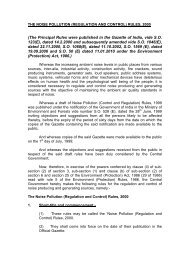
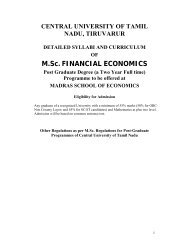
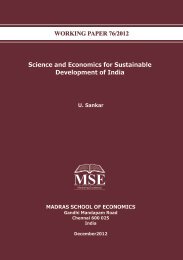
![Curriculum Vitae [pdf] - Madras School of Economics](https://img.yumpu.com/49878970/1/190x245/curriculum-vitae-pdf-madras-school-of-economics.jpg?quality=85)
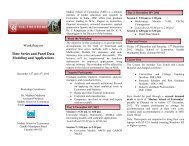
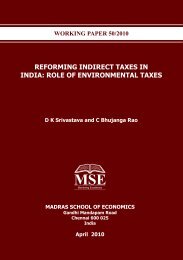
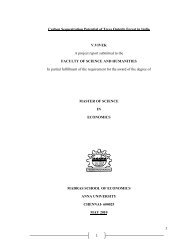
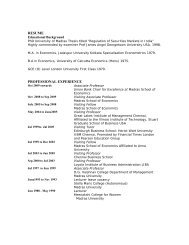
![Curriculum Vitae [pdf] - Madras School of Economics](https://img.yumpu.com/48715201/1/184x260/curriculum-vitae-pdf-madras-school-of-economics.jpg?quality=85)
